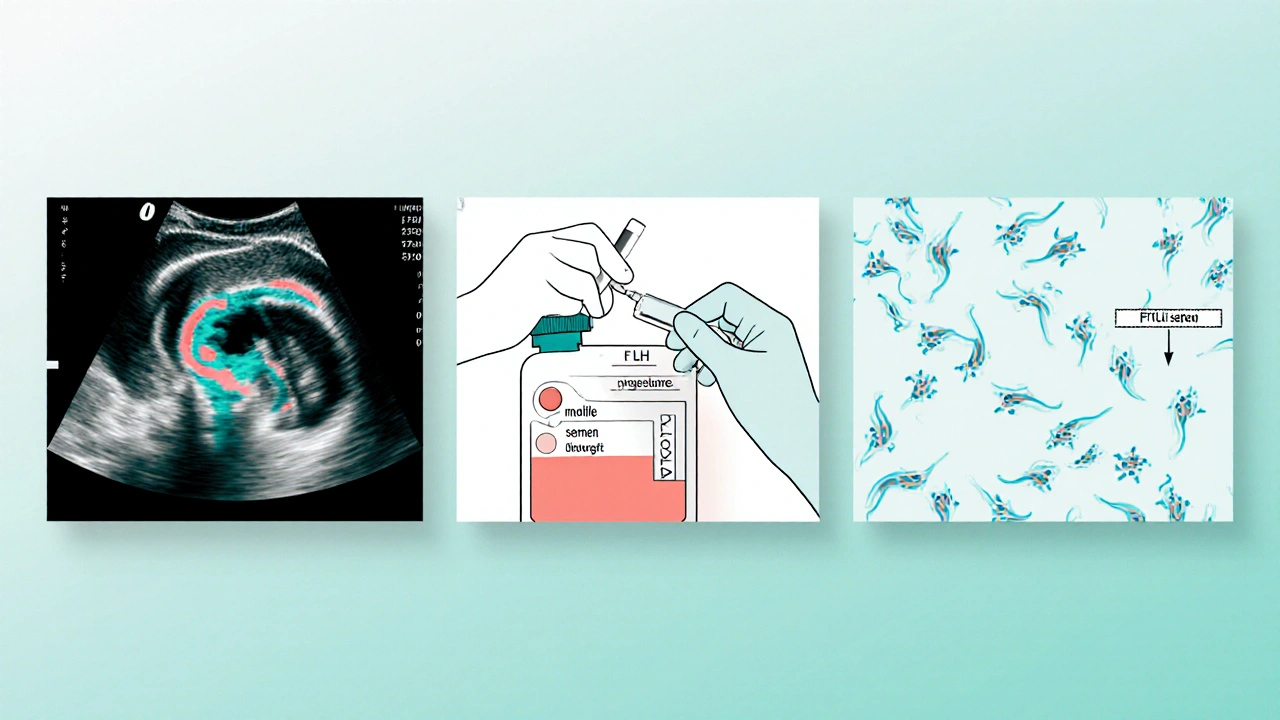Infertility & Miscarriage Risk Calculator
Personal Information
Lifestyle Factors
Medical History
Assessment Results
Risk Level
Recommendations
Did You Know?
When couples start trying for a baby, they often hear mixed messages about why pregnancy sometimes doesn’t happen or ends early. The truth is that both infertility and miscarriage have clear medical explanations, but myths, stress, and a lack of reliable information make the journey feel overwhelming.
Key Takeaways
- Infertility affects about 1 in 7 couples; miscarriage occurs in roughly 15% of recognized pregnancies.
- Hormonal, anatomical, genetic and lifestyle factors can cause either condition, and many overlap.
- Early, accurate testing-blood hormone panels, ultrasound, and sperm analysis-helps pinpoint the problem.
- Treatment ranges from lifestyle changes and medication to assisted reproductive technologies such as IVF.
- Emotional support and clear communication with healthcare providers are essential for both partners.
What Is Infertility?
Infertility is a condition where a couple does not achieve pregnancy after 12 months of regular, unprotected intercourse. In the UK, the National Health Service defines primary infertility as the inability to conceive, while secondary infertility refers to difficulty becoming pregnant again after a previous successful pregnancy. Age is a major factor: women’s fertility starts to decline noticeably after 35, and men’s sperm quality can drop after 40.
Common medical causes include:
- Ovulation disorders - irregular or absent release of an egg, often linked to polycystic ovary syndrome (PCOS) or thyroid imbalance.
- Sperm count issues - low concentration, poor motility or abnormal morphology, which can stem from varicocele, infection, or lifestyle factors.
- Uterine or tubal abnormalities - blocked fallopian tubes, fibroids, or congenital uterine malformations.
- Endometriosis - tissue similar to the uterine lining grows outside the uterus, causing inflammation and scarring.
- Genetic factors - chromosomal translocations or single‑gene mutations that affect gamete quality.
What Is Miscarriage?
Miscarriage, also called spontaneous abortion, is the loss of a pregnancy before 20 weeks gestation. Most miscarriages occur before the 12th week and are often discovered only after a missed period or spotting.
Key reasons include:
- Chromosomal abnormalities in the embryo - responsible for roughly 50% of early losses.
- Uterine structural problems - such as a septate uterus or severe adhesions (Asherman's syndrome).
- Hormonal imbalances - low progesterone levels can prevent the uterine lining from supporting an embryo.
- Infections - bacterial vaginosis, listeria or certain sexually transmitted infections increase risk.
- Lifestyle influences - smoking, excessive caffeine, high alcohol intake, and extreme body weight (both underweight and obesity).

Where Infertility and Miscarriage Overlap
Although they seem opposite-one is difficulty getting pregnant, the other is losing a pregnancy-many underlying factors affect both. For example, hormonal disorders like PCOS can cause anovulation (leading to infertility) and also create a hostile uterine environment that raises miscarriage risk. Similarly, poor sperm DNA integrity can hinder fertilisation and increase the chance of chromosomal defects in the embryo.
| Aspect | Infertility | Miscarriage | Shared Factors |
|---|---|---|---|
| Typical Timeline | 12+ months of trying | Loss < 20 weeks | Hormonal imbalances |
| Primary Test | Semen analysis, ovulation tracking | Ultrasound, hormonal panel | Genetic testing (chromosomal) |
| Common Treatment | Clomiphene, IVF, lifestyle changes | Progesterone supplementation, surgical correction | Addressing PCOS, endometriosis |
Getting an Accurate Diagnosis
Both partners should undergo a thorough evaluation early in the journey. Here’s a typical step‑by‑step pathway:
- Comprehensive medical history - noting menstrual patterns, previous pregnancies, surgeries, and lifestyle.
- Blood tests - measuring FSH, LH, estradiol, thyroid hormones, and progesterone.
- Ultrasound assessment - checking ovarian follicles, uterine cavity, and endometrial thickness.
- Semen analysis - evaluating volume, concentration, motility, and morphology.
- Genetic screening - karyotype testing for both partners if recurrent loss or unexplained infertility persists.
- Specialist referral - to a reproductive endocrinologist or a high‑risk obstetrician for complex cases.
Treatment Options Overview
Interventions are tailored to the specific cause and the couple’s preferences. Major categories include:
- Lifestyle modifications - achieving a healthy body‑mass index, quitting smoking, limiting alcohol, and managing stress.
- Medication - Clomiphene citrate or letrozole to trigger ovulation; Gonadotropins for more intensive stimulation; Progesterone supplements for luteal‑phase support.
- Assisted reproductive technologies (ART)
- In‑vitro fertilisation (IVF) - eggs are retrieved, fertilised in the lab, and transferred back to the uterus.
- ICSI - intracytoplasmic sperm injection, used when sperm quality is a concern.
- Egg or sperm donation - for cases of severe gamete deficiencies.
- Surgical correction - laparoscopy for endometriosis, hysteroscopy to remove uterine polyps or septa.
Success rates vary: in the UK, IVF cycles for women under 35 achieve a live‑birth rate of about 40%, while donor egg IVF can exceed 55%.

Emotional and Practical Support
The psychological toll is real. Couples report anxiety, depression, and feelings of isolation. Here are practical steps to stay resilient:
- Seek counseling - a therapist specialising in fertility issues can help process grief.
- Join support groups - local charities like the Fertility Charity (UK) run meet‑ups and online forums.
- Maintain open communication - keep both partners informed about test results and emotions.
- Plan financially - ART can be costly; explore NHS eligibility, private insurance, or financing schemes.
Debunking Common Myths
- Myth: “Stress alone causes infertility.”
Fact: While chronic stress can affect hormone levels, most cases have a clear physiological cause. - Myth: “If you’ve had a miscarriage, you’re unlikely to have a healthy baby later.”
Fact: About 80% of women who experience one loss go on to have a successful pregnancy. - Myth: “Age only matters for women.”
Fact: Male age influences sperm DNA quality; men over 45 have a modest increase in miscarriage risk.
Next Steps Checklist
- Schedule a visit with a reproductive specialist.
- Complete recommended blood tests and semen analysis.
- Discuss lifestyle changes and set achievable targets (e.g., 5‑10% weight loss).
- Review treatment options - medication first, then ART if needed.
- Arrange emotional support - therapist, support group, or trusted friend.
- Track progress - keep a journal of cycle dates, test results, and feelings.
Frequently Asked Questions
Can infertility be cured without medical intervention?
In many cases, simple lifestyle adjustments-like achieving a healthy weight, quitting smoking, and reducing alcohol-can improve fertility enough to achieve pregnancy naturally. However, if an underlying medical condition such as blocked tubes or severe sperm abnormalities exists, medical treatment is usually required.
How many miscarriages are considered recurrent?
Two or more consecutive pregnancy losses before 20 weeks define recurrent miscarriage. This triggers a more thorough investigation, including genetic, anatomical and hormonal testing.
Is IVF covered by the NHS?
Eligibility varies by region and clinical criteria. Generally, couples under 40 with a specific diagnosis (e.g., tubal blockage) may qualify for up to three full IVF cycles through the NHS.
What role does progesterone play after a miscarriage?
Progesterone supports the uterine lining, helping it rebuild after a loss. In women with documented luteal‑phase deficiency, supplementing progesterone can improve chances of a subsequent healthy pregnancy.
Can male factors cause miscarriage?
Yes. Poor sperm DNA fragmentation can lead to chromosomal errors in the embryo, increasing the risk of early miscarriage. Testing for DNA fragmentation is an emerging tool in recurrent loss work‑ups.

While the calculator offers a convenient overview, it's essential to recognize the underlying epidemiological data that informs those risk scores. Age, particularly beyond thirty‑five, carries a statistically significant increment in miscarriage probability, and BMI deviations further modulate hormonal balance. Moreover, the impact of chronic stress-often overlooked in simplistic tools-can exacerbate both infertility and early pregnancy loss. Remember, a one‑size‑fits‑all metric may gloss over nuanced personal histories.
Honestly, the tool is pretty handy for getting a quick snapshot of where you stand. Just plug in the basics-age, BMI, smoking status-and you’ll see a color‑coded risk level pop up. It’s not a crystal ball, but it does give you a starting point to talk with a doctor. Plus, the “Did You Know?” facts are a neat way to learn something new :)
The present risk calculator, while visually appealing, suffers from an oversimplification of a multifactorial biomedical phenomenon.
Infertility and miscarriage are governed by a labyrinthine interplay of genetic, immunologic, and environmental variables that cannot be distilled into a handful of checkboxes.
Age, indeed, is a paramount determinant, yet the algorithm fails to differentiate between ovarian reserve decline and uterine receptivity loss.
Body mass index, as employed here, treats underweight and overweight extremes with identical weight, ignoring adipokine signaling nuances.
Smoking status is reduced to a binary label, disregarding pack‑year history and secondhand exposure, both of which modulate vascular integrity.
Alcohol consumption thresholds are arbitrarily set at fourteen units per week, a figure derived from outdated epidemiological cohorts.
Caffeine intake is merely tallied in cups, overlooking variations in brew strength and individual metabolic clearance rates.
Past pregnancy losses are aggregated without assessing inter‑pregnancy intervals or underlying etiologies such as antiphospholipid syndrome.
The inclusion of “Known Medical Conditions” lumps heterogeneous disorders-from PCOS to thyroid dysfunction-under a single penalization factor.
Family history is treated as a monolithic risk boost, ignoring penetrance disparities among first‑degree versus more distant relatives.
Moreover, the risk scoring system adds fixed points without scaling for interaction effects, thereby inflating or deflating true risk.
From a statistical perspective, the algorithm appears to employ a rudimentary linear additive model, unsuitable for capturing non‑linear dynamics inherent in reproductive biology.
Clinical decision‑making, therefore, demands a more granular assessment than what this interface supplies.
It is advisable for individuals to complement the calculator’s output with comprehensive hormonal panels, uterine imaging, and genetic screening where indicated.
Ultimately, while the tool can spark conversation, it should never replace personalized consultation with a reproductive endocrinologist.
Hey folks, don’t let a high score on this calculator deter you-it’s just a data point, not a destiny. Lifestyle tweaks like balanced nutrition, regular moderate exercise, and stress‑reduction techniques have been shown to improve reproductive outcomes. If you’re feeling overwhelmed, consider joining a support group; sharing experiences can be incredibly empowering. Remember, many people turn initial setbacks into eventual success stories. Keep pushing forward, and lean on your healthcare team for tailored guidance.
Building on what Leon mentioned, it’s also useful to track your cycles using a fertility app to spot patterns that might not be evident otherwise. Open communication with your partner about goals and anxieties can foster a supportive environment. Don’t hesitate to ask your doctor about micronutrient supplementation, especially folic acid and vitamin D, which have modest evidence for benefit. Every incremental improvement adds up over time.
Look, the whole “risk calculator” feels like another data grab by big pharma, feeding us numbers that push us toward costly interventions. They never tell you that environmental toxins hidden in everyday products can wreak havoc on gamete quality. There’s a whole underground community that’s already mapping these hidden hazards. If you’re truly serious about safeguarding your fertility, start scrutinizing your household chemicals and water supply. The mainstream narrative conveniently omits these critical factors.
Indeed, the exposome-the totality of environmental exposures-from endocrine‑disrupting chemicals like phthalates to persistent organic pollutants, has profound implications on both gametogenesis and embryonic implantation.
Recent metabolomic studies employing high‑resolution mass spectrometry have delineated distinct biochemical signatures correlating with sub‑fertile phenotypes.
Moreover, epigenetic modulation via DNA methylation patterns can be triggered by chronic low‑level toxin exposure, leading to transgenerational effects that are not captured by a simplistic risk slider.
While the calculator aggregates lifestyle factors, it neglects to incorporate biomarkers such as serum anti‑Müllerian hormone (AMH) levels, which offer a more direct quantification of ovarian reserve.
In practice, a multimodal assessment integrating exposomic data, hormonal profiling, and ultrasonographic antral follicle count yields a more robust prognostic model.
Therefore, it is prudent to complement the online tool with targeted laboratory evaluations and environmental audits of your living space.
Ignoring these dimensions risks perpetuating a false sense of security based on incomplete data.
Stay hydrated.
Consistency is key-track your habits daily and share the log with your OB‑GYN for a clearer picture of what’s going on.
The suggestion to “track habits daily” aligns with evidence‑based practice; however, it is essential to record data in a structured format-preferably using a spreadsheet with categorical columns for diet, sleep, and stress levels-to facilitate objective analysis. Random anecdotes lack the rigor needed for clinical interpretation.
Enough with the bland health advice-our country has some of the best fertility specialists, and it’s high time we stop looking abroad for solutions. The government’s recent funding boost for reproductive research will make top‑tier care accessible to everyone. If you’re serious about beating infertility, book an appointment at a certified clinic and demand the latest protocols. No more excuses.
While national pride can motivate us, true progress stems from collaborative humility and listening to each patient’s unique story. Embracing both cutting‑edge science and compassionate care creates a fertile ground for hope 🌱. Let’s champion advancements while honoring individual journeys.
The presentation of risk metrics in the calculator suffers from a lack of transparency regarding the underlying statistical model, raising concerns about its validity. Without access to confidence intervals or a clear description of weighting algorithms, users cannot assess the reliability of the output. Such opacity is indicative of a broader trend in health tech where usability is prioritized over scientific rigor.
Agreed. Demand full methodology before trusting any health app.
I’ve tried a few of these tools myself and found they’re decent for getting a quick baseline, but I always double‑check the numbers with my doctor. It’s a helpful conversation starter, not a diagnosis.